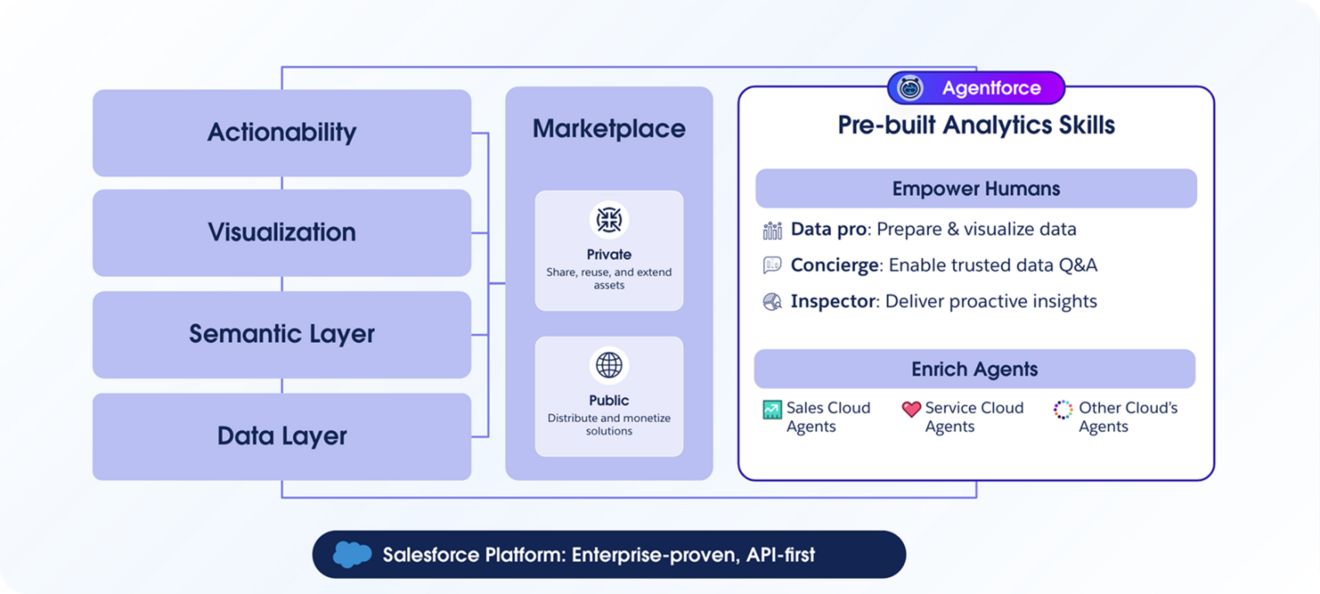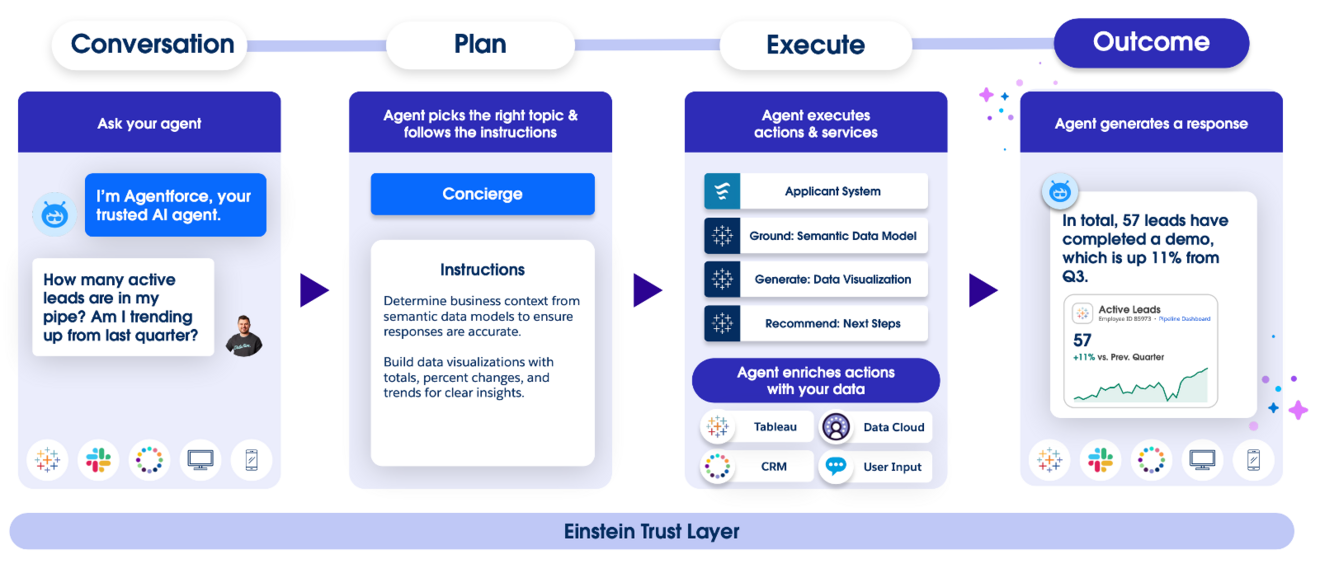What Does Tableau Next Mean for Traditional Tableau Environments?
It’s important to understand: Tableau Next does not replace existing Tableau products. Tableau Server, Tableau Cloud, Tableau Desktop, and Tableau Prep will remain available and continue to be actively developed. For many organizations—especially those with on-premise requirements or not embedded in the Salesforce ecosystem—these remain reliable and appropriate solutions.
Salesforce has deliberately adopted a dual-platform approach: Tableau Classic and Tableau Next will coexist, each with its own strengths and areas of application.
What this means for organizations:
-
Planning security: Existing investments in Tableau Classic retain their value.
-
Flexibility: Those not yet using Salesforce can continue with Tableau Classic—without limitations.
-
Freedom of choice: A move to Tableau Next can happen gradually—via pilot projects, hybrid architectures, or targeted use cases.
There is no pressure to switch immediately—but there are compelling reasons to explore Tableau Next early.
Tableau Classic is Evolving, too: Feature Highlights
Salesforce is continuing to invest in the traditional Tableau products. Upcoming releases confirm that innovation isn’t limited to Tableau Next:
Analytics & Visualization
-
Interactive parameters on maps
-
New color palettes and modern design with rounded UI elements
-
"Instant Viz" – automatic visualization suggestions based on underlying data
-
Enhanced Q&A feature in Tableau Pulse for natural language queries
-
VizQL Data Service on Tableau Server – enables programmatic access to visualizations via APIs
Notable for AI users: Integration with Langchain via the VizQL Data Service enables new LLM-powered interactions, such as with chatbots or virtual assistants.
Generative BI & Authoring Automation
Data Integration & Preparation
-
In-database processing in Tableau Prep for better data flow performance
-
Native Python scripting in Tableau Cloud
-
Direct integration with dbt to connect data engineering and visualization more closely
User Experience & Accessibility
Governance & Administration
-
SCIM support for automated user management
-
"Recycle Bin" for restoring deleted content
-
Granular view-level activity logs for compliance and auditing
Conclusion: Those using Tableau Classic can expect ongoing innovation—with gradual integration of AI features and strong support for hybrid scenarios.
Tableau Next or Tableau Classic – Which Is Right for You?
The answer depends on your current setup and strategy.
-
Use Tableau Next if you are deeply integrated into the Salesforce ecosystem and seeking AI-powered, future-ready analytics—especially for goals like data activation, automation, and semantic modeling.
-
Use Tableau Classic if you rely on on-premise infrastructure or prefer a mature, highly customizable analytics platform—independent from Salesforce, with strong self-service and governance capabilities.
Quick Comparison:
Tableau Next | Tableau Classic |
- AI-native, cloud-only, tightly integrated into Salesforce
| - Proven, flexible, available on-premise
|
- Agentic AI & semantic layer for intelligent processes
| - Manual visualizations, user-driven exploration
|
- Trigger actions & workflows directly from dashboards
| - Focus on self-service BI & reporting
|
- Data activation & contextual insights
| - Versatile integration, Salesforce-independent
|
- Part of Agentforce & Data Cloud
| - Stable, mature, and evolving
|
Usage Recommendation
-
Tableau Next: For organizations with a strong Salesforce focus, cloud-first strategy, and ambitions to use data and agents for automated, intelligent workflows.
-
Tableau Classic: For those relying on established BI processes—whether on-premise or cloud—with robust governance and platform independence.
-
Hybrid Model: For many companies, the pragmatic path. Use Tableau Classic for exploratory analysis and dashboarding, while leveraging Tableau Next for agent-driven, forward-looking use cases (e.g., automation, real-time actions).
Shared data assets—via the Salesforce Data Cloud—enable consistency and reusability across both platforms. This hybrid model allows you to retain proven structures while exploring agent-based BI today, without needing a disruptive "big bang" transition.
Real-World Example: Customer Retention with AI and Real-Time Data
A Europe-wide utility provider wants to improve service center satisfaction and reduce churn risk by moving from reactive analysis to automated, real-time interventions.
Current setup:
-
Salesforce CRM is in use, but behavioral and usage data reside in separate systems (SAP, data lake, IoT).
-
Tableau Server provides insights—but no automation.
Solution with Tableau Next:
-
Salesforce Data Cloud aggregates data from CRM, ERP, IoT, and service tickets into a unified Customer 360 model.
-
The semantic layer in Tableau Next defines key metrics like churn risk, service quality, and usage score.
-
Agentforce activates key skills:
4. The interactive Tableau Next dashboard displays:
Result:
The company can act before the customer churns—with personalized, data-driven responses. Analytics becomes a living part of the business process: intelligent, integrated, and impactful.
Why Companies Should Engage with Tableau Next Now
Tableau Next is not just an update—it’s a paradigm shift. It merges modern data architecture with AI, automation, and embedded agents to form a platform that goes far beyond traditional data analysis. Early adopters benefit from:
-
Competitive advantages
-
Scalable infrastructure via Salesforce Data Cloud
-
A strategic leap toward AI-driven, agent-enabled organizations
Market Positioning: Tableau Next in the Analytics Landscape
Salesforce isn't alone in pushing toward AI-driven, proactive Business Intelligence. Other platforms are also adopting agent-based models, semantic layers, and automated actions:
-
Microsoft Power BI: Strong integration with Microsoft 365 & Copilot
-
Amazon QuickSight: Cloud-native, ML-driven, developer-focused
-
ThoughtSpot: Emphasizes natural language “Search-to-Insight”
-
Google Looker: Model-based consistency via LookML on GCP
Tableau Next stands out in three key ways:
-
Deep business process integration – via Salesforce workflows, embedded actions, and agent logic
-
Agentforce as a cross-platform engine for a Digital Workforce (in Tableau, Slack, Service Cloud, etc.)
-
Focus on Data Activation – turning insight into immediate, intelligent action
For enterprises, Tableau Next offers more than visualization—it becomes a core enabler of data-driven business transformation.
M2 – Your Strategic Partner for Tableau Next
As one of the most experienced Tableau partners in the DACH region, M2 helps organizations unlock the full potential of Tableau Next—competently, practically, and with an open approach to technology.
What M2 offers for Tableau Next:
-
Comprehensive integration expertise:
Seamless data connections across Salesforce and external systems (cloud lakehouses, ERPs, IoT, legacy platforms)—all orchestrated within the Salesforce Data Cloud.
-
Agentic AI success enabler:
Foundation for intelligent agents like Concierge, Inspector, and Data Pro—enabled by high-quality data, consistent semantic modeling, and strong data governance practices.
-
End-to-end support for real-world use cases:
From data onboarding to semantic modeling to integration into business-critical decision processes—M2 delivers complete, scalable solutions from one source.
How We Support Your Tableau Next Journey:
Tableau Next Readiness Assessment
→ Review of your current infrastructure & data landscape
→ Gap analysis, opportunity identification & strategic recommendationse
Tableau Next Pilot Implementation Package
→ Delivery of a specific use case
→ From data integration to visualization to embedded workflows
Interested? Get in touch to learn how Tableau Next can transform your analytics strategy:
Contact
![[Translate to English:] [Translate to English:]](/fileadmin/_processed_/9/f/csm_neu_5a59160a93.jpg)


